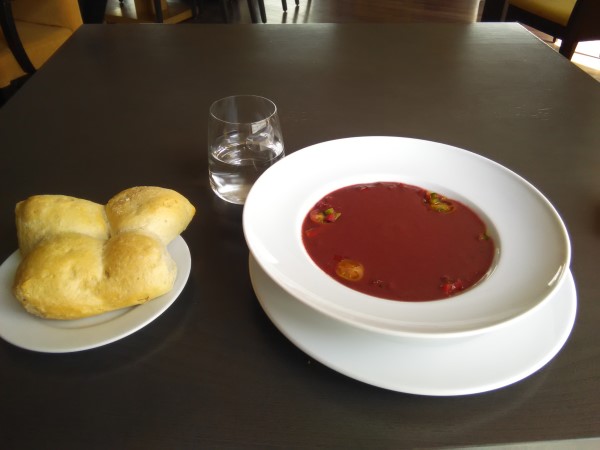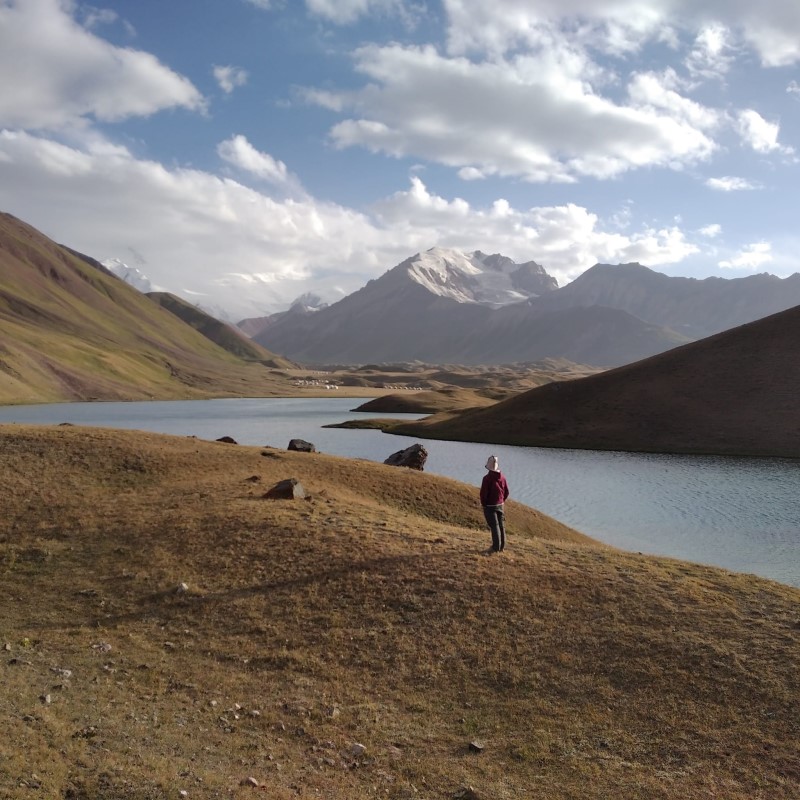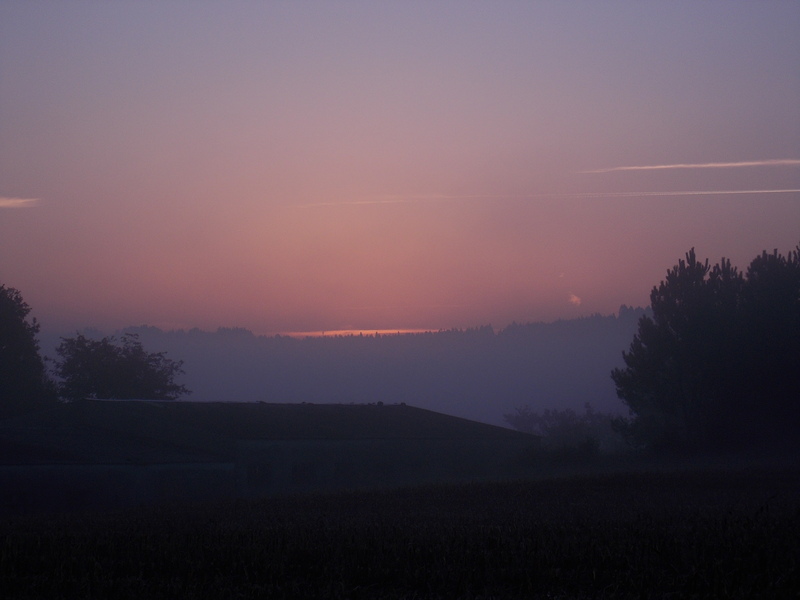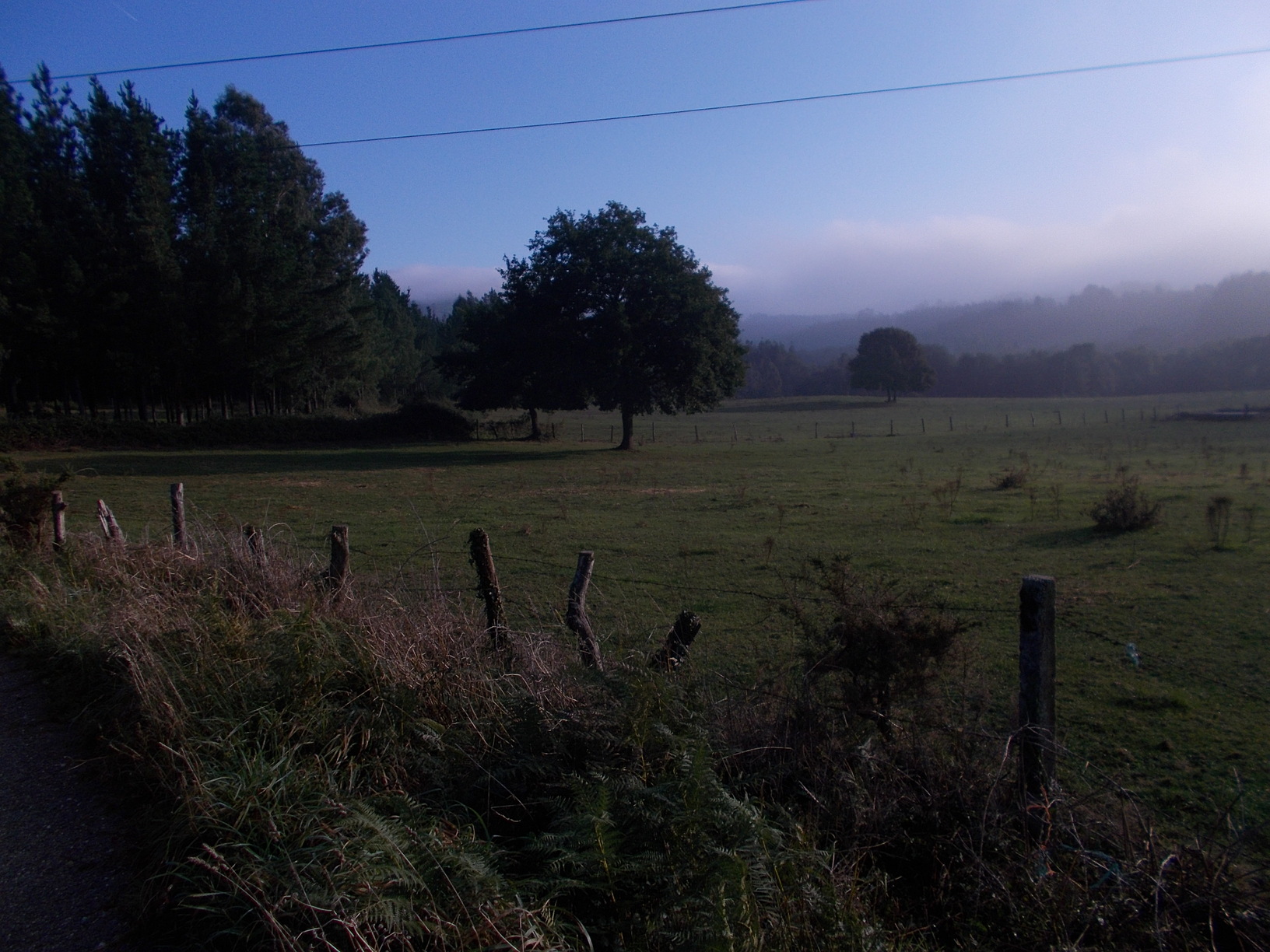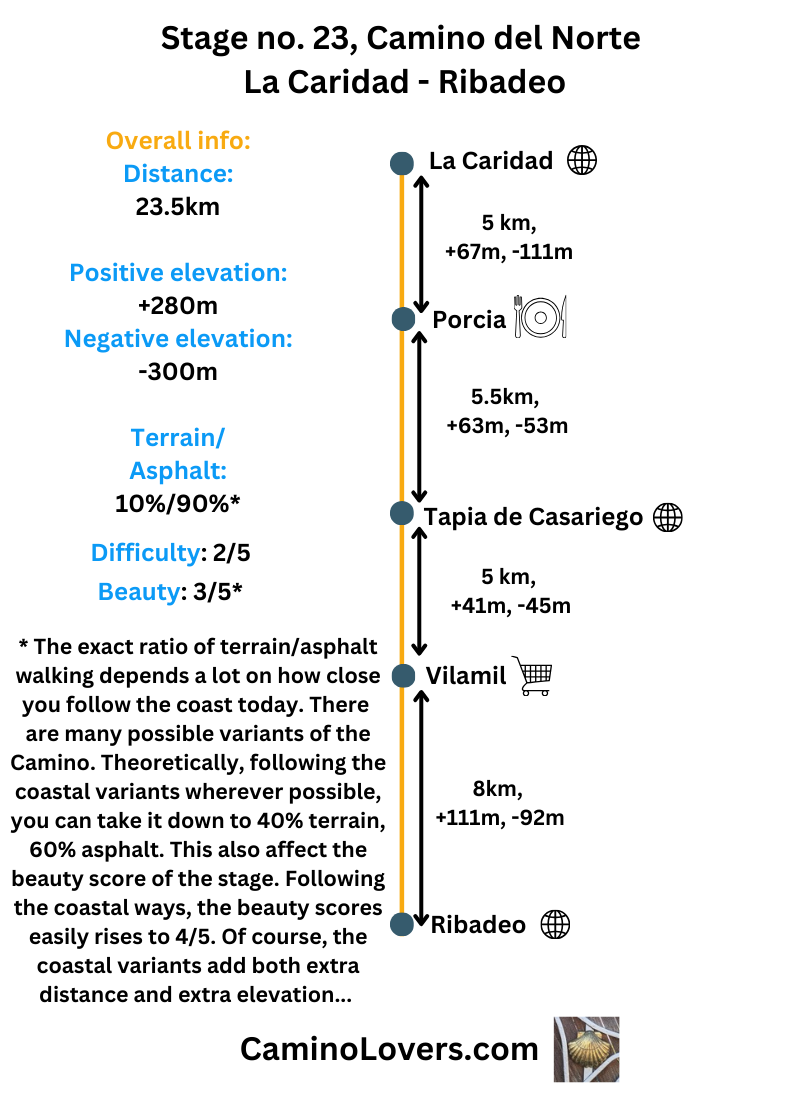
Basic Details
- Starting point: The city center of La Caridad, a nice town of Asturias with roughly 2,000 inhabitants, all services, and two pilgrim hostels with decent reputation.
- Ending point: The city center of Ribadeo, the first town on your Camino in Galicia, with roughly 10,000 inhabitants and all services for pilgrims.
- Availability of alternative routes: YES. There are two possibilities today. One of them follows the coast, and passes through a nice town of Tapia de Casariego, and the second one goes inland, following mostly quiet roads and almost avoiding any towns or refreshment points all the way to ribadeo. Traditionally, the inland variant was considered the “official Camino”. However, since roughly 75% of pilgrims take the coastal variant nowadays, we will discuss it here as a primary route, and call the inland variant as an alternative. Both variants have something to offer as you will learn in the later sections of this guide.
- Distance: Coastal variant: 24 km (download GPS here). Inland variant: 22km (download GPS here).
- Elevation difference: Coastal variant: +280m, – 300m. Inland variant: +260m, -280m.
- Link to online map: Coastal variant: here. Inland variant: here.
- Difficulty score: 2/5, for both coastal and inland variant.
- Beauty score: Coastal route: 3/5. Inland route: 2/5.
- Terrain/asphalt: Coastal route: 10%/90% . Inland variant: 15%/85% (this time around, the coastal alternative doesn’t really add any extra miles on nice small trails or at least gravel roads, however, it adds some really nice views :)).
- Next stage: Camino del Norte, stage no. 24, Ribadeo – Mondonedo.
- Previous stage: Camino del Norte, stage no. 22 – Luarca – La Caridad.
Elevation profile for the routes
 – Coastal variant over Tapia, looks relatively eventful on the picture, but that’s only because you won’t get higher than 65 meters over sea level today, and hence small climbs look bigger on the chart. If you look at the gradient, however, you’ll see that there’s only one descent with 8% gradient, and it is less than 500 meters long. All in all, considering the standards of Camino del Norte, this is one of the flattest stages on the entire Camino. Since you will walk mostly on paved roads, I gave it a difficulty score of 2/5 only. And easy one for a change :).
– Coastal variant over Tapia, looks relatively eventful on the picture, but that’s only because you won’t get higher than 65 meters over sea level today, and hence small climbs look bigger on the chart. If you look at the gradient, however, you’ll see that there’s only one descent with 8% gradient, and it is less than 500 meters long. All in all, considering the standards of Camino del Norte, this is one of the flattest stages on the entire Camino. Since you will walk mostly on paved roads, I gave it a difficulty score of 2/5 only. And easy one for a change :).
 – The inland variant of today’s walk, pretty similar to the coastal one in terms of flatness, just a bit shorter, which is perhaps the main reason why roughly 25% of pilgrims take it, instead of following the coastal variant over Tapia de Casariego.
– The inland variant of today’s walk, pretty similar to the coastal one in terms of flatness, just a bit shorter, which is perhaps the main reason why roughly 25% of pilgrims take it, instead of following the coastal variant over Tapia de Casariego.
Advanced info about the stage
- Trail marking: I have to make a distinction here between the coastal variant and the inland variant.
- The inland variant is sign-posted perfectly well, and it is also easy for orientation, since there aren’t really any wrong turns you can take, and for the last 10 kilometers you basically follow the AS-31 road (just for the case of interest, “AS” means Asturias, and 31 is the road number, this is the way Spanish authorities name the local roads, according to the provinces they belong to). In any case, you do not need to worry about getting lost or walking extra on the inland variant.
- The coastal variant is a bit more tricky, since traditionally this wasn’t a sign-posted camino, and when they signposted it, they changed the exact way several times. Originally the Camino used to take the pilgrims very close to the coast, but now it is not the case, and in order to visit some beaches or places worth seeing, you need to make short detours in the direction of the coast. But some old yellow arrows are still there, which can easily misled one. Not that you will get lost (the really coastal paths eventually connect to the bigger paved path that pilgrims should follow), it will just add some extra kilometers and meters of elevation to your walk :).
- Natural places worth seeing:
- I have to start with the river zone of Ribadeo. The river zone is a natural protected area, called ZEPA Ribadeo, and you can observe a quantity of protected birds and other animal species here. You can see the list of birds living in the area here (the website is in Spanish, translate the page to English with Google to see the English names of the birds, if you’re into bird watching). The town of Ribadeo has build a nice net of walking paths along the river, frequented mostly by locals. It makes for a perfect peaceful afternoon walk, once you have dropped your backpack in the hostel.
- The coastal zone of Ribadeo, with several nice beaches to visit, and the famous Faro de Ribadeo, a lighthouse in a beautiful green location, isolated on a small isle accessible by a bridge. A place where everyone takes a picture.
- Overall there are several nice (and relatively touristic) beaches, should you follow the coastal variant over Tapia de Casariego. Most of them are rocky, but offer nice views and there is almost always a beach bar nearby. Probably my favorite one is the Playa de Paloma, for its sand, natural beauty and interesting rock formations. For one reason or another, it is slightly less touristic than other beaches in the zone of Tapia. The beach is roughly 350 meters away from the signposted camino.
- Historical, architectural, and culinary places worth seeing:
- Palacio de Trenor – A beautifully renovated palace from the 16th century. It serves now as a luxury place for organizing events such as weddings (darn expensive), and hence they won’t let you inside. However, it s very beautiful from outside as well, and with a nice port in the neighborhood. About 300 meters detour from the Camino.
- Molino de las Mareas – An interesting water mill a bit outside of the city of Ribadeo, accessible by a nice pathway along the river Ribadeo. Very well preserved, and a great alternative for a nicely spent afternoon for history and architecture lovers.
- Camping/bivouac options on this stage: Really good for organized camping, with plenty of options. For wild camping it is harder (the coastal zone here is rather touristic and highly urbanized, with not many trees to hide among), but if you do not have other option than wild camping, I’d suggest the recreational area of Arnao, which offers some nice protected spots among trees. Keep in mind though that the place is quite busy on any sunny day of the summer, and you better come just in the evening before sunset, and pitch your tent somewhere where is isn’t too much on the eyes. When it comes to organized camping places, I’d recommend the following:
- Camping playa de Tapia: Ideal for s short day for those who want to prolong their pilgrimage on the coast for an extra day :). Fantastic location with beaches and views, dog friendly, clean, good reputation. Can get loud in summer night, so that’s something to count with.
- Camping Vegamar: One of the best organized camping places on the entire northern coast. Super clean, well maintained, dog friendly, lot of facilities, run with love (and not only for money, which is the case in many camping places in Spain). 500 meters detour from the coastal camino.
- Camping Ribadeo: A bit outside of the city (and the camino, roughly 3 km detour), but a great budget option. Rather simple and a bit without atmosphere, but clean and dog friendly.
- Dog friendly score: 3/5. An average stage for dogs. Little shade (on both coastal and inland variant of the way), but on the other hand you’ll pass by a few recreational areas on the coast with trees and water fountains. The roads are not busy, but the bridge crossing can be super scary for a dog (it is long, always trembling because of traffic, etc), and if your dog doesn’t like such things (80% of dogs don’t like long bridge crossings, let alone with traffic) you may consider taking a train from the station belonging to Tapia de Casariego (! it is actually close to the the inland Camino (1 km detour), not on the coastal one) to Ribadeo, avoiding the bridge crossing on foot. There is typically one train around midday (12:30pm), and the ride takes about half an hour. Make sure to check the exact schedule online or on any train station (it is the route from Oviedo to Ferrol). In Ribadeo you will find one hostel that actually accepts dogs, called albergue Viruxe.
- Special remarks: The crossing of the bridge to Ribadeo also marks your crossing from the province of Asturias to the province of Galicia. Now you’re already in Galicia, the last province you will walk through on your pilgrimage towards Santiago. From here on the camino turns inland, so today is also your last option to enjoy a coast, and perhaps a swim in the Atlantic ocean.
Accommodation options on today’s stage
* The infographic displays the number of pilgrim hostels (only pilgrims allowed), hostels (anyone allowed, shared rooms), and other accommodation options (hotels, pensions, etc, private rooms) in each point along the route, together with price range. For exact explanation of the pictograms we use check the explanations page. Below the infographic you will see our recommended picks (up to 3 pilgrim options and 1-2 “privacy” options, maximum five) for the stage, together with important information (but not too much info, just what you need :-)).

Recommended places to sleep along this stage
Pilgrim options:
- Albergue de Peregrinos de Tapia, Tapia de Casariego (km 10). Location and reviews on Google maps here. Donation-based, 10 beds. A municipal albergue in a wonderful location, right next to the beach “Playa de Represas“. Good reviews across all pilgrim platforms. It is a basic albergue, but the municipality of Tapia keeps it well. Which means it is clean and all facilities are in decent condition, which is certainly something we cannot say about all municipal albergues… Check-in in the tourist office (500 meters from the albergue, well indicated on the door), from 10am to 1:30pm and from 5pm to 7:30pm. If you arrive in-between and someone is already in the albergue, you can go in and simply register later on. Does not accept reservations.
- Hostel Anam Cara, Serantes (15 km, 15 minutes detour from the Camino). Location and reviews on Google maps here. A new hostel oriented towards pilgrims, though anyone can stay there. Almost luxurious, isolated, peaceful location. Everything new and in perfect condition, including the kitchen installations. Run by native English speakers. Great reviews across different pilgrim platforms, and since it is outside of the Camino, and kind of “in the middle of two stages”, it rarely gets full. 10 beds, prices from 20 euro/night. Check-in from 2pm, recommended way of making a reservation: booking.com.
- Albergue Camino Norte, Figueras (km 21, 300 meters from the inland Camino). Location and reviews on Google Maps here. A very well organized rural hostel close to nice beaches of Figueras. 16 beds, 20 euro/night, dinner 10 extra, breakfast 4 extra. For anyone (not only for pilgrims), but the vibe is nice and the place has good reviews across all platforms. Recommended way of making a reservation: booking.com.
- Albergue de Peregrinos de Ribadeo, Ribadeo (km 23). Location and reviews on Google maps here. 12 beds, 10 euro/bed. A decent municipal albergue in a wonderful location (right on the edge of the river Eo) with a very small number of beds considering the location. Luckily Ribadeo is a relatively big city and offer many other accommodation options, including some hostels, though none of them is particularly great… Anyway, check-in from 1pm, doesn’t accept reservations. If you want to get a bed there, you should be there ideally at noon already, waiting… I would not recommend this albergue to certain travelers, however, see “few tips at the end” section for more information.
Luxury/privacy options:
- Hotel O Cabazo, Ribadeo (km 23). Location and reviews on Google maps here. One of the best rated hotels in the zone, and probably the best one in terms of price/quality ratio. Great location (close to two river beaches, to the center, and at the same time in a relatively quiet location), recently renovated, very kind English speaking staff, big rooms, balconies, everything… Prices from 80 euros/night (goes up in high season), check-in from 3pm. Recommended way of making a reservation: booking.com.
Pictures from the stage
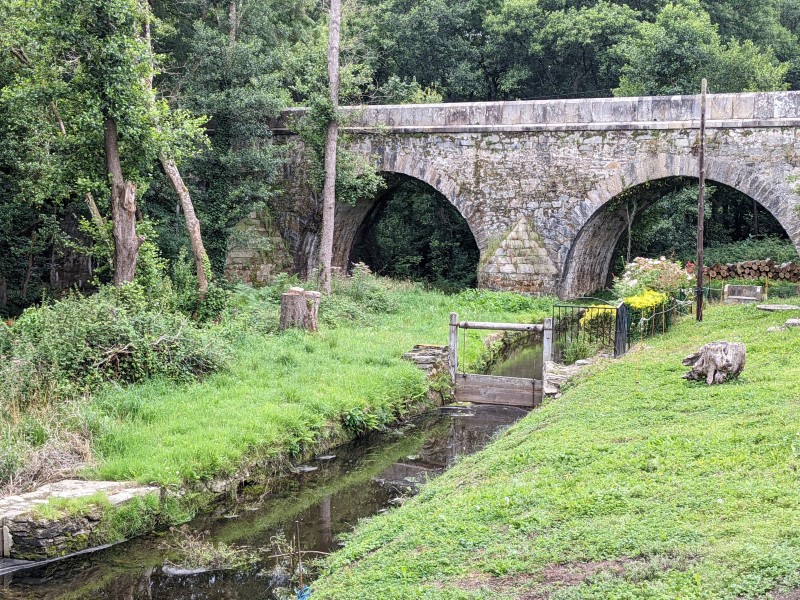 – A nice small Roman bridge you will pass by on today’s walk.
– A nice small Roman bridge you will pass by on today’s walk.
 – One of the stony beaches you will pass by on today’s walk from La Caridad to Ribadeo.
– One of the stony beaches you will pass by on today’s walk from La Caridad to Ribadeo.
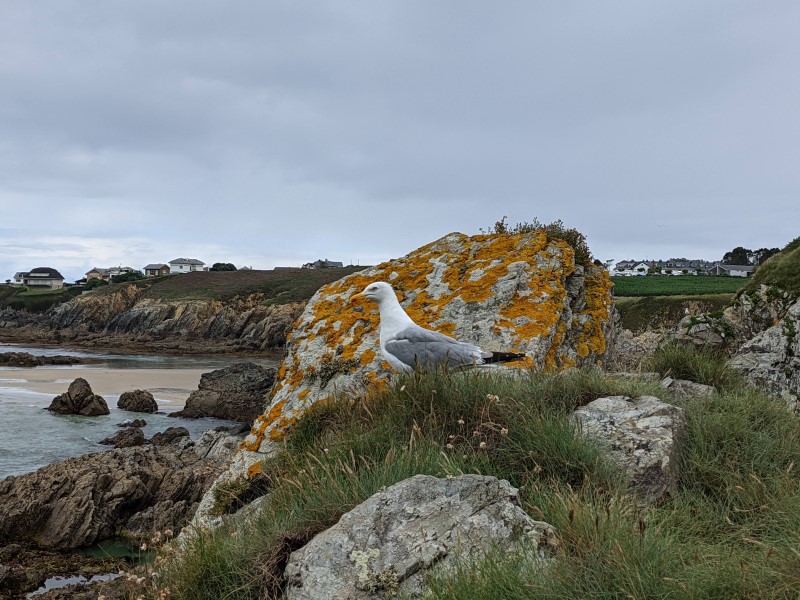 – Anytime I felt lonely on this camino, I went to talk with one of the sea gulls. They are very frequent in the zone, and as soon as you start eating something they will land close to you, preying for any leftovers.
– Anytime I felt lonely on this camino, I went to talk with one of the sea gulls. They are very frequent in the zone, and as soon as you start eating something they will land close to you, preying for any leftovers.
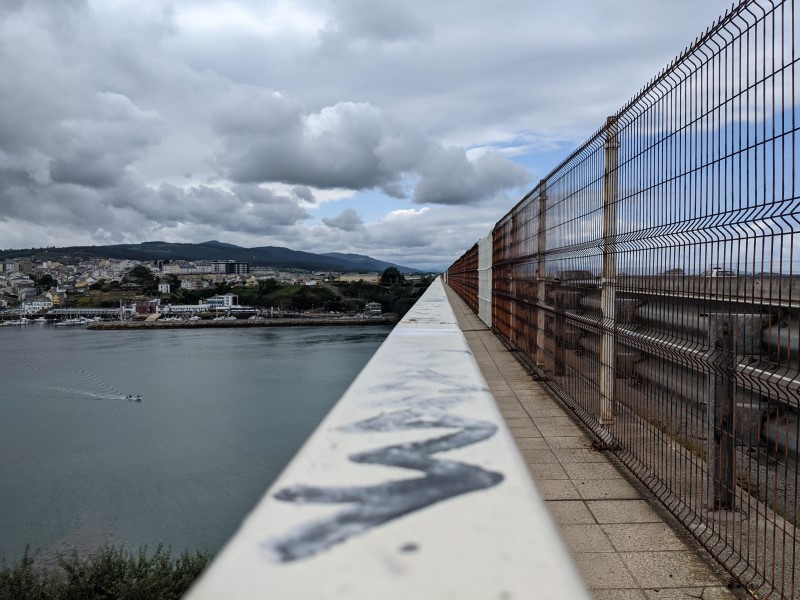 – the (in)famous long bridge you have to cross over the Rio Ribadeo, in order to reach the city. Pilgrims, cyclists, cars–they all share the same bridge, but luckily there is a separate path, though narrow, protected by fence, for pedestrians and cyclists. And while it is certain improvement, the path is rather narrow and passing a cyclist for example is rather tricky. The bridge gives a scare to many pilgrims, but just like any other challenge on your pilgrimage, you will eventually overcome it :).
– the (in)famous long bridge you have to cross over the Rio Ribadeo, in order to reach the city. Pilgrims, cyclists, cars–they all share the same bridge, but luckily there is a separate path, though narrow, protected by fence, for pedestrians and cyclists. And while it is certain improvement, the path is rather narrow and passing a cyclist for example is rather tricky. The bridge gives a scare to many pilgrims, but just like any other challenge on your pilgrimage, you will eventually overcome it :).
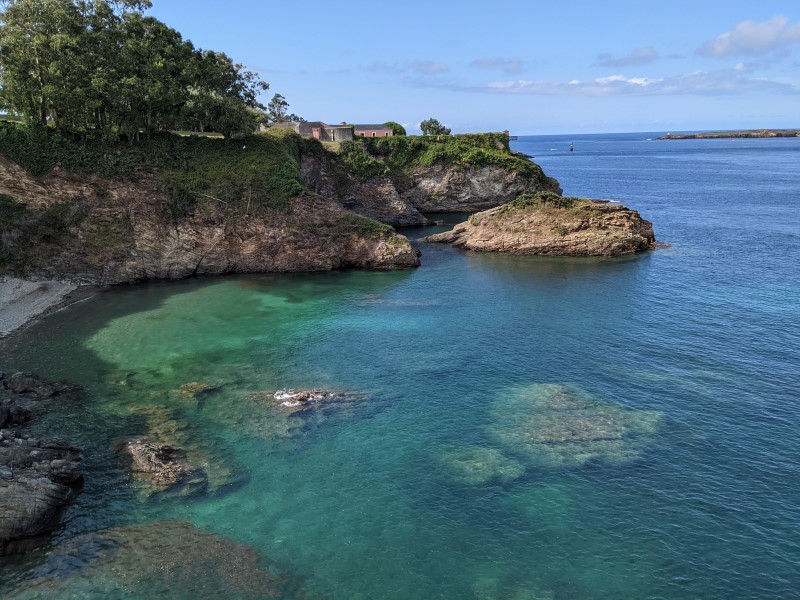 – The coastal zone of Ribadeo, colorful and with a lot of variety, definitely worth exploring in the afternoon, once you have already left your backpack in the albergue.
– The coastal zone of Ribadeo, colorful and with a lot of variety, definitely worth exploring in the afternoon, once you have already left your backpack in the albergue.
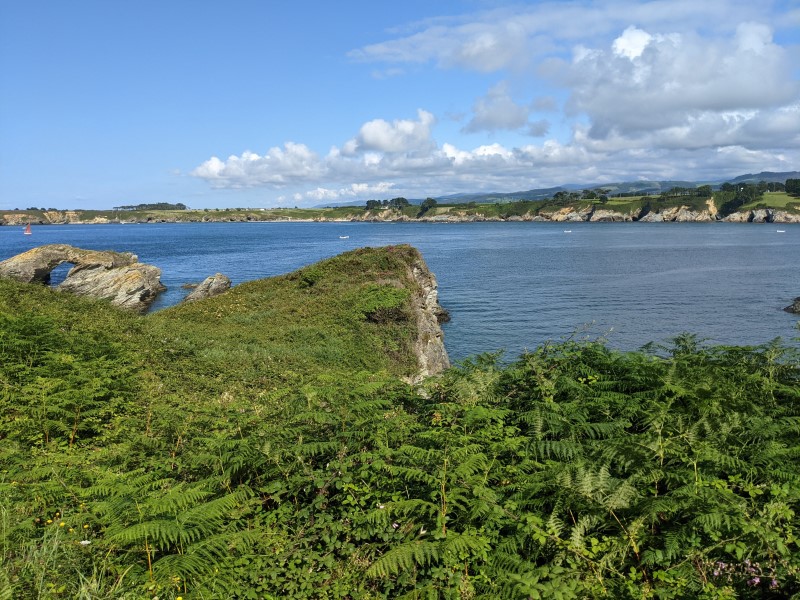 – The river of Ribadeo, perhaps the widest river you cross on your entire Camino from Irun. The river zone in the city is picturesque and a protected natural area as well, and you can walk along it on nicely made paths, frequented mostly by local runners, dog walkers, etc.
– The river of Ribadeo, perhaps the widest river you cross on your entire Camino from Irun. The river zone in the city is picturesque and a protected natural area as well, and you can walk along it on nicely made paths, frequented mostly by local runners, dog walkers, etc.
 – Descent to the small beach called “Playa de Rocas Blancas“, my favorite beach in Ribadeo. While is is mostly a stone beach, it is nicely protected from winds, it isn’t touristic, and has a great vibe overall. The walk from the city center to this beach is also nice.
– Descent to the small beach called “Playa de Rocas Blancas“, my favorite beach in Ribadeo. While is is mostly a stone beach, it is nicely protected from winds, it isn’t touristic, and has a great vibe overall. The walk from the city center to this beach is also nice.
Few tips at the end
- While I am not a big fun of cities, Ribadeo is definitely worth exploring in the afternoon. The river zone is a protected natural reserve (you can spot many interesting bird species just walking along the river and paying attention), and the coastal zone is as colorful and variable as it gets, offering some breath-taking views (the favorite spot for taking pictures is no doubt the Faro de Ribadeo) and beaches worth a visit and an afternoon swim :).
- You should also not forget that this is your last day on the coast, because tomorrow we’ll head into the inland Galicia, and you won’t see the sea anymore. Another reason to explore the coastal zone of this beautiful town and dive into the water for one last time on your pilgrimage…
- If you’re a solo female pilgrim, I suggest you to avoid the municipal albergue in Ribadeo. There are enough stories of strange characters entering late in the evening to sleep there, due to the way the albergue is run (no hospitalero in the evening), and its location…
Next stage/Previous stage
- Next stage: Camino del Norte, stage no. 24, Ribadeo – Mondonedo.
- Previous stage: Camino del Norte, stage no. 22 – Luarca – La Caridad.



![Ultralight Packing List for Camino de Santiago [2025 Edition]](https://caminolovers.com/wp-content/uploads/2022/03/altra-shoes-640-x-480.jpg)
